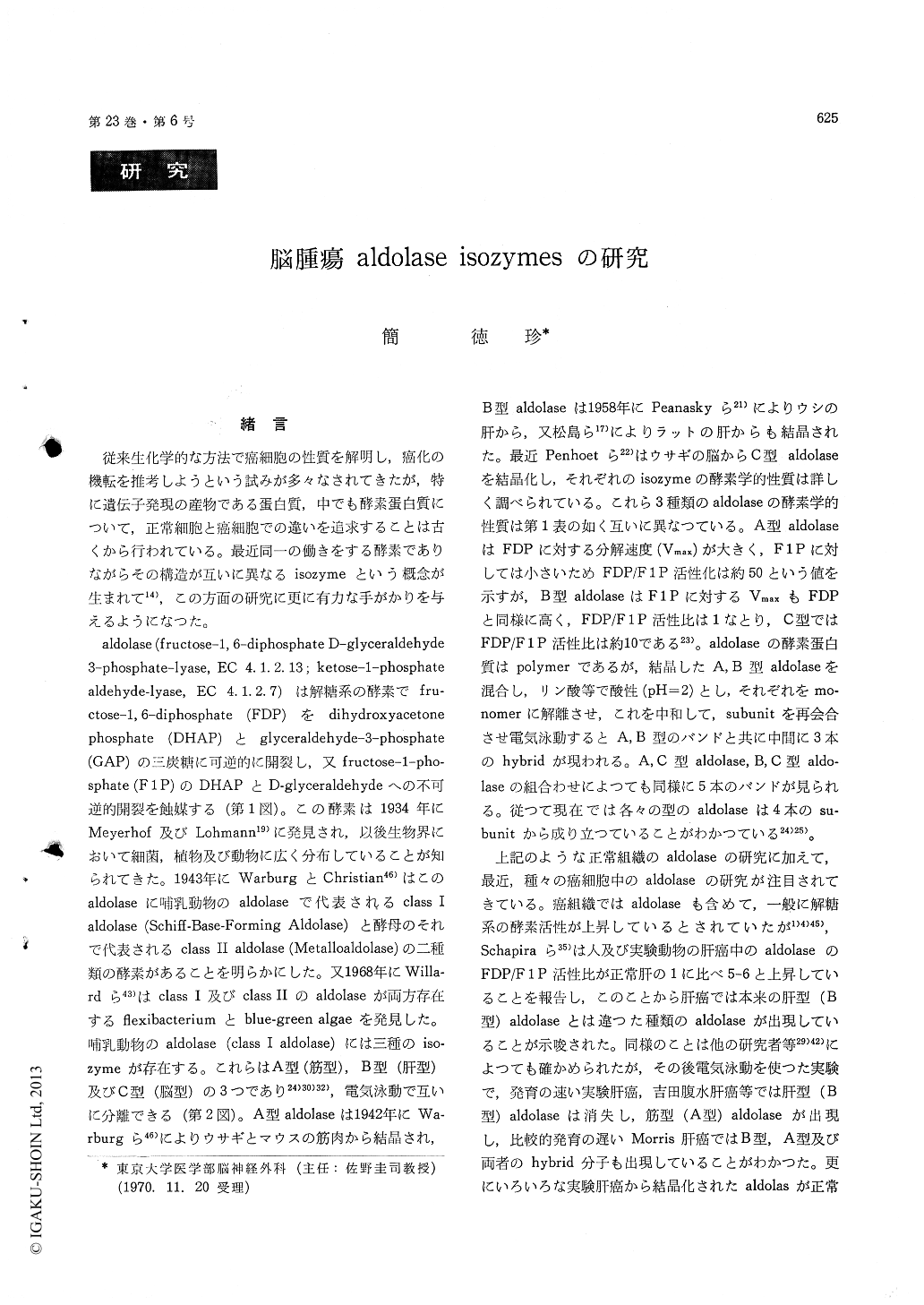Japanese
English
- 有料閲覧
- Abstract 文献概要
- 1ページ目 Look Inside
緒言
従来生化学的な方法で癌細胞の性質を解明し,癌化の機転を推考しようという試みが多々なされてきたが,特に遺伝子発現の産物である蛋白質,中でも酵素蛋白質について,正常細胞と癌細胞での違いを追求することは古くから行われている。最近同一の働きをする酵素でありながらその構造が互いに異なるisozymeという概念が生まれて14),この方面の研究に更に有力な手がかりを与えるようになつた。
aldolase (fructose−1,6—diphosphate D-glyceraldehyde3—phosphate-lyase,EC 4.1,2,13;ketose−1—phosphatealdehyde-lyase,EC 4.1.2.7)は解糖系の酵素でfru—ctose−1,6—diphosphate (FDP)をdihydroxyacetonephosphate (DHAP)とglyceraldehyde−3—phosphate(GAP)の三炭糖に可逆的に開裂し,又fructose−1—pho—sphate (F1P)のDHAPとD-glyceraldehydeへの不可逆的開裂を蝕媒する(第1図)。この酵素は1934年にMeyerhof及びLohmann19)に発見され,以後生物界において細菌,植物及び動物に広く分布していることが知られてきた。1943年にWarburgとChristian46)はこのaldolaseに哺乳動物のaldolaseで代表されるclass Ialdolase (Schiff-Base-Forming Aldolase)と酵母のそれで代表されるclass II aldolase (Metalloaldolase)の二種類の酵素があることを明らかにした。又1968年にWilla—rdら43)はclass I及びclass IIのaldolaseが両方存在するflexibacteriumとblue-green algaeを発見した。哺乳動物のaldolase (class I aldolase)には三種のiso—zymeが存在する。これらはA型(筋型),B型(肝型)及びC型(脳型)の3つであり24)30)32),電気泳動で互いに分離できる(第2図)。A型aldolaseは1942年にWa—rburgら46)によりウサギとマウスの筋肉から結晶され,B型aldolaseは1958年にPeanaskyら21)によりウシの肝から,又松島ら17)によりラットの肝からも結晶された。最近Penhoetら22)はウサギの脳からC型aldolaseを結晶化し,それぞれのisozymeの酵素学的性質は詳しく調べられている。これら3種類のaldolaseの酵素学的性質は第1表の如く互いに異なつている。A型aldolaseはFDPに対する分解速度(Vmax)が大きく,F1Pに対しては小さいためFDP/F1P活性化は約50という値を示すが,B型aldolaseはF1Pに対するVmaxもFDPと同様に高く,FDP/F1P活性比は1なとり,C型ではFDP/F1P活性比は約10である23)。aldolaseの酵素蛋白質はpolymerであるが,結晶したA,B型aldolaseを混合し,リン酸等で酸性(pH=2)とし,それぞれをmo—nomerに解離させ,これを中和して,subunitを再会合させ電気泳動するとA,B型のバンドと共に中間に3本のhybridが現われる。A,C型aldolase,B,C型aldo—laseの組合わせによつても同様に5本のバンドが見られる。従つて現在では各々の型のaldolaseは4本のsu—bunitから成り立つていることがわかつている24)25)。
Three parental aldolases, termed A (muscle al-dolase), B (liver aldolase) and C (brain aldolase) have been detected in mammalian tissue.
These three enzymes have different substrate specificities towards fructose-1, 6-diphosphate (FDP) and fructose-l-phosphate (F 1 P) as well as different activity ratio FDP/F 1 P (50 in A, 1 in B and 10 in C).
The normal brain tissue shows bands of aldolase A and aldolase C with three hybrid bands (A4, A3C, A2C2, AC3 and C4) electrophoretically.
The specific activity of aldolase of the brain tumors is variable but FDP/FIP ratio is similar to that of the normal brain. Since there is no cor-relation detected between the activities of aldolase derived from different brain tumors, it is difficult to determine their natures by aldolase activity only.
As to isozyme pattern, A and C with three hy-brid bands in the normal brain and A4 and A3C mainly with a trace of A2C2 in the fetal brain (3 months) are separated by cellulose acetate mem-brane electrophoresis. These results in our study coincide with the reports by other authors.
In gliomas, which are of neuroepithelial origin, the isozyme pattern resembles that of the normal brain in general, but it seems to have a tendency that the bands of C4, AC3 and A2C2 disappear in relation to malignancy of tumors. In some of glio-blastoma, C4, AC3 and A2C2 are absent while only two bands of A4 and A3C exist. Thus aldolase C peptide is always present in neuroepithelial element.
On the other hand, in meningioma which is a mesodermal tumor, two patterns are obtained, namely a type of A4 and the other type of A4 and A3C.
From this fact, brain tumors originated from neuroepithelium or mesoderm may be distinguished by the difference of the isozyme patterns of aldolase C peptide.
In pituitary adenoma, the bands of A4 and a trace of A3C are seen.
In all the metastatic tumors of the brain, which the author so far has examined, such as from the lung, the stomach and the breast, the isozyme pattern reveals two bands of A4 and A3C.
As mentioned above, the aldolase isozyme pattern reflects the origin of tumors and it may be useful clinically for the diagnosis of brain tumors.

Copyright © 1971, Igaku-Shoin Ltd. All rights reserved.


